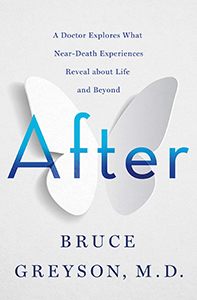 Bruce Greyson, After: A Doctor Explores What Near-Death Experiences Reveal About Life and Beyond (New York: St. Martin's, 2021), 258pp.
Bruce Greyson, After: A Doctor Explores What Near-Death Experiences Reveal About Life and Beyond (New York: St. Martin's, 2021), 258pp.
I've never had a near-death experience (NDE), but I have a good friend who did. Art was a pediatric immunologist at a prestigious university, famous for his pioneering work on HIV-AIDS, who spoke to a group of Christian faculty at Stanford University that I had gathered. With total clarity and confidence, that morning he described how during surgery on his heart, he had an out-of-body experience in which he looked down upon his body on the operating table, and then returned to normal life.
It's easy to be dismissive of some claims to NDE's (see the two articles by Gottlieb below); there's some sensationalist stuff out there. But as Bruce Greyson shows, "pretending something didn't happen just because you can't explain it isn't science; that's the opposite of science." Greyson has a legitimate claim to be the "father" of what is now fifty years of extensive research about NDE's. He's a clinical and academic psychiatrist, the author of over a hundred peer-reviewed articles in medical journals on the subject, and the co-founder of the International Association for Near-Death Studies (founded in 1981) and its journal (which he edited). Today he's Professor Emeritus of Psychiatry and Neurobehavioral Research at the University of Virginia. And for what it's worth, he describes himself as irreligious.
Similar to the numerous books by Oliver Sacks, a large percentage of this book incorporates the clinical anecdotes by people who have had NDE's. They are fascinating to read with their many different voices describing very similar experiences. Greyson has collected over a thousand such stories of NDE's. Along with colleagues, he has tried to standardize the field. For example, they created a checklist of sixteen characteristic features or patterns in NDE's (the life review, time slowing down, looking down upon one's physical body, feelings of bliss, the sense that the experience is "more real" than anything they have experienced, etc.).
Greyson challenges the scientific skepticism that is dismissive of NDE's. In particular, he addresses the criticism that NDE research data is "only" anecdotal, compared to the gold standard of controlled studies. He explains the controversies surrounding the relationship between the mind and the brain (he believes that consciousness exists independently of the brain). He is modest in his conclusions, and freely admits that the research data is open to various explanations. "But there is one thing about which I am certain," he says, "about which the evidence is overwhelming — and that is the effect of NDE's on people's attitudes, beliefs, and values. If you take only one thing from this book, I would want you to appreciate the transformative power of these experiences to change people's lives."
It's a bit dated now, but for more on this subject from a skeptical perspective, see the two-part article by Robert Gottlieb, "To Heaven and Back!" NYRB (October 23, 2014), and "Back from Heaven — The Science," NYRB (November 6, 2014), which considers about two dozen books on NDE's.
Dan Clendenin: dan@journeywithjesus.net


